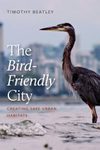![How Green Became Good How Green Became Good]()
Click to have a closer look
About this book
Contents
Customer reviews
Biography
Related titles
About this book
As projects like Manhattan's High Line, Chicago's 606, China's eco-cities, and Ethiopia's tree-planting efforts show, cities around the world are devoting serious resources to urban greening. Formerly neglected urban spaces and new high-end developments draw huge crowds thanks to the considerable efforts of city governments. But why are greening projects so widely taken up, and what good do they do? In How Green Became Good, Hillary Angelo uncovers the origins and meanings of the enduring appeal of urban green space, showing that city planners have long thought that creating green spaces would lead to social improvement. Turning to Germany's Ruhr Valley (a region that, despite its ample open space, was "greened" with the addition of official parks and gardens), Angelo shows that greening is as much a social process as a physical one. She examines three moments in the Ruhr Valley's urban history that inspired the creation of new green spaces: industrialization in the late nineteenth century, postwar democratic ideals of the 1960s, and industrial decline and economic renewal in the early 1990s. Across these distinct historical moments, Angelo shows that the impulse to bring nature into urban life has persistently arisen as a response to a host of social changes, and reveals an enduring conviction that green space will transform us into ideal inhabitants of ideal cities. Ultimately, however, she finds that the creation of urban green space is more about how we imagine social life than about the good it imparts.
Contents
Introduction: Urban Greening beyond Cities
Part 1 Green Becomes Good
1 The Imaginative Turn to the City
2 Building an Urban Future through Nature
Part 2 Contested Social Ideals
3 The Space-Time of Democracy: Parks as a Bourgeois Public Sphere
4 Proletarian Counterpublics: Reimagining the Colonies
Part 3 The Social Life of Urbanized Nature
5 Producing Nature, Projecting Urban Futures
6 Experiencing Nature as a Public Good
Conclusion: Global Greening Today
Acknowledgments
References
Index
Customer Reviews
Biography
Hillary Angelo is assistant professor of sociology at the University of California, Santa Cruz. Her work has been published in Theory and Society, the International Journal of Urban and Regional Research, and Nature, among other journals.
By: Hillary Angelo(Author)
259 pages, 14 b/w photos and b/w illustrations
"Angelo risks sacrilege; she takes on nature as a mundane tool of politics, entertainment, and real estate. The ideology of green comes out of its black box, exposed to insightful and historically aware analysis."
– Harvey Molotch, New York University
"Written with verve and meticulous attention to historical detail, How Green Became Good illuminates the hows and whys of the contemporary phenomenon of 'urbanized nature'. Angelo convincingly moves from micro-level investigations of moral judgments and responses surrounding pet rabbits to macro-level examinations of top-down globalized urban greening projects. A tour de force, this book will prompt a rethinking of the green-as-good reflex."
– Robin Wagner-Pacifici, The New School for Social Research
"How Green Became Good takes the conventional western urban imagination out of Chicago's Loop and past Los Angeles's Sixty-Mile-Circle to the expanse of the Ruhr and rewrites urban theory from there. This brilliant book on more than a century of "urbanized nature" in Germany's former industrial heartland will forever change our views of the industrial city as preceding the green city. If you are looking for a concept of the urban beyond the Zwischenstadt, you will find it in Angelo's magisterial contribution."
– Roger Keil, York University



































